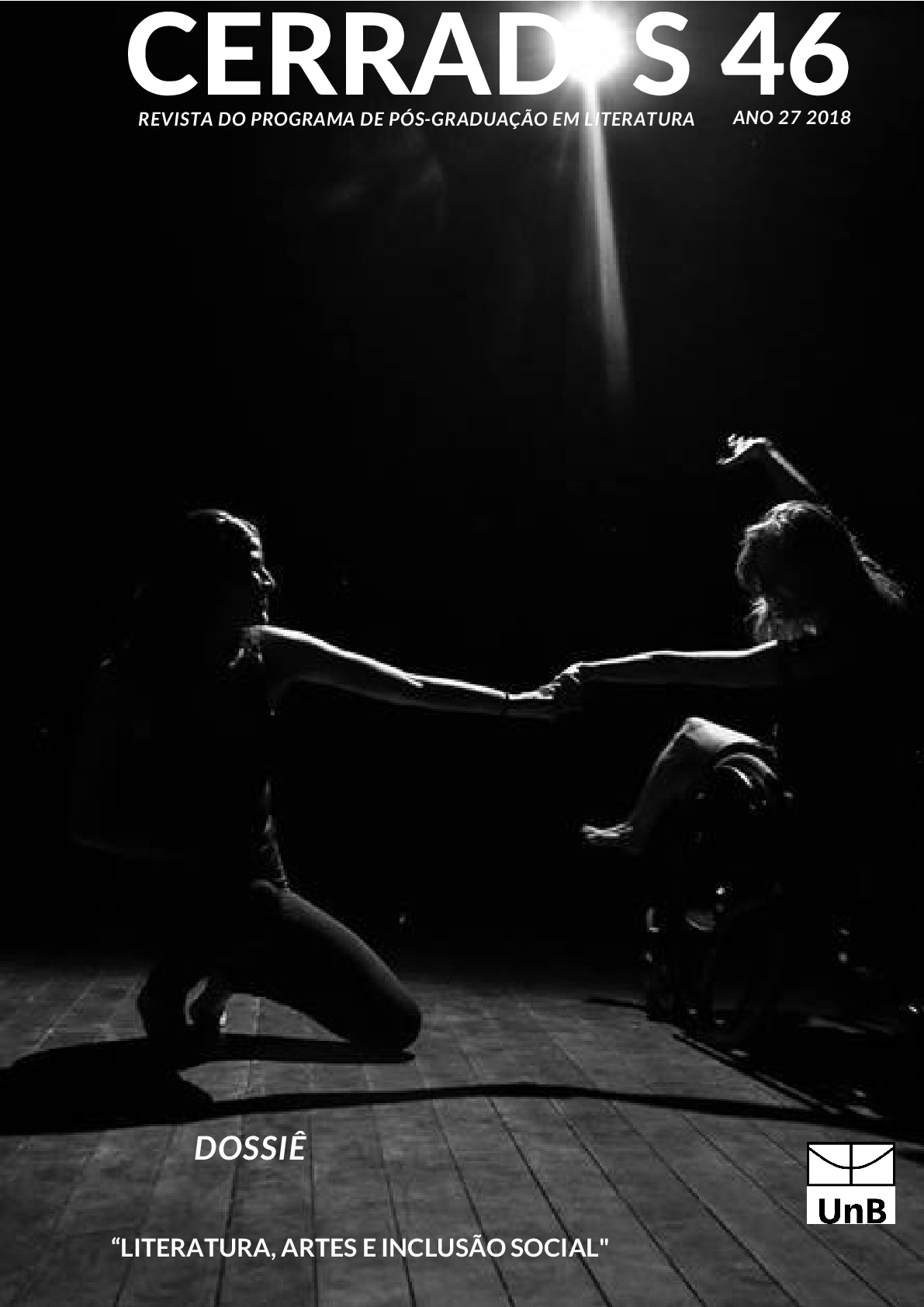The Use of Comic Material in the Tragedy of Shakespeare and His Contemporaries
DOI:
https://doi.org/10.26512/cerrados.v27i46.19642Keywords:
Comic element. Shakespearean Tragedy. Clown. LaughterAbstract
This article reflects on the presence of the figure of the clown, whose comic scenes are recurrent in tragic texts, as well Shakespeare as his predecessors and contemporaries, to get to the point these texts, by the author’s suggestion, call tragicomedy or comitragedy. The scholar proposes groups of types of comic passages within Renaissance plays, emphasizing that Shakespeare is the great exponent of the use of comicity in his tragic plays, however, in chronological perspective, Alden exposes how laughter, seen as the consequence of comedy in detriment of the clowns’ actions, is crossed by authors predecessors and contemporaries to Shakespeare.
Downloads
References
ALDEN, Raymond Macdonald. The Use of Comic Material in the Tragedy of Shakespeare and His Contemporaries. The Journal of English and Germanic Philology, Illinois, vol. 13, nº. 2, 1914, p. 281-298.
Referências Complementares
ADDISON. N. 40 ”“ Monday, April 16, 1711. In: MORLEY, Henry (ed). The Spectator: A New Edition Reproducing the Original Text Both as First Issued and as Corrected by its Author. Volume 1. London: George Routledge and Sons, 1891.
BAKER, George Pierce. Hamlet Prince of Denmark: The Tudor Shakespeare. USA: MacMillan, 1913.
BRADLEY, Andrew Cecil. Shakespearean Tragedy: Lectures on Hamlet, Othello, King Lear, Macbeth. 1. ed. Glasgow: Glasgow University Press, 1904.
COLLIER, John Payne. Memoirs of the principal actors in the plays of Shakespeare. London: Shakespeare Society, 1846.
CORBIN, John. The Elizabethan Hamlet: a study of the sources and of Shakespeare's environment, to show that the mad scenes had a comic aspect now ignored. London: London E. Mathews, 1895.
DRYDEN, John. Dedication to Spanish Friar, or the double discovery (1681). In: KER, Willian Paton (ed). Essays of John Dryden. Vol. 1. Oxford: Clarendon Press, 1906, p. 244-250.
DYCE, Alexander. Introduction and notes. In: KEMP, William. Nine Daies Wonder: Performed in a daunce from London to Norwich. London: Camden Society, 1839, p. V-XXVII. Disponível em: <http://www.gutenberg.org/files/21984/21984-h/21984-h.htm>. Acesso em: 19 abr. 2017.
FURNESS, Horace Howard. A New Variorum Edition of Shakespeare: Hamlet. New York: Dover Publications, 1871.
FURNIVALL, Frederic. The New Shakspere Society's Transactions. Michigan: Trübner & Company, 1880.
GAYLEY, Charles Mills. An Historical View of the Beginnings of English Comedy. GAYLEY, Charles Mills (ed). Representative English Comedies: From the Beginnings to Shakespeare. London: Macmillan & Co, LTD, 1903, p. xi-xcii.
HALES, John Wesley. Notes and Essays on Shakespeare. London/New York: 1892.
HAWKESWORTH, John. Prologue to Oroonoko alter’d. In: SOUTHERNE, Thomas. Plays written by Thomas Southerne with An Account of the life and writings. Vol 1. Oxford: Oxford University School of English, 1774, p. 8.
JOHNSON, Samuel. Dr. Johnson’s Preface. In: MALONE, Edmond. The Plays and Poems of William Shakspeare: Prolegomena. Volume 1, Part 1. London: H. Baldwin, 1790, p. 1-49.
KEMPE, William. In: LEE, Sidney (ed). Dictionary of National Biography. 1.ed. New York/London: MacMillan/Smith and Elder, 1892. Vol. XXX: JOHNNES - KENNETH, p. 390-394. Disponível em: <https://archive.org/stream/dictionarynatio54stepgoog#page/n400/mode/2up>. Acesso em: 16 nov. 2018.
LESSING, Gotthold Ephraim. Hamburgische Dramaturgie. Michigan: University of Michigan Library, 1890.
LOUNSBURY, Thomas. Shakespeare as a Dramatic Artist: with an account of his reputation at various periods. New York: Charles Scribner’s Sons, 1908.
MILTON, John. Samson Agonistes. In: MILTON, John. Paradise regain'd: a poem in IV books to which is added Samson Agonistes. London: Printed by J[ohn]. M[acock]. for John Starkey at the Mitre in Fleestreet, near Temple-Bar, 1671, p. 9- 101.
RYMER, Thomas. From the Tragedies of the Last Age: consider’d and examin’d by the practice of the Ancients and by the common sense of all ages (1678). In: SPINGARN, Joel Elias. Critical Essays of the 17th Century, Oxford: Clarendon Press, 1908, p. 181-208.
SCHELLING, Felix Emanuel. English Literature During the Lifetime of Shakespeare. New York: H. Holt, 1910.
SIMPSON, Richard. School of Shakespeare. London: Chatto and Windus, 1878.
STOLL, Elmer Edgar. John Webster: The Periods of His Work as Determined by His Relations to the Drama of His Day. 1905.
THÜMMEL, Julius Sigismund. Ueber Shakespeare’s Clowns, Shakespeare-Jahrbuch, vol. 11, p. 78-96, 1876.
VOLKELT, Johannes. Ästhetitk des Tragischen. Munchen: Beck, 1897.
WENDELL, Barrett. William Shakespeare: a study in Elizabethan literature. New York: Charles Cribner’s Sons, 1912.
WHETSTONE, George. The Dedication to Promos and Cassandra. In: SMITH, George Gregory. Elizabethan Critical Essays. Vol I. London: Oxford University Press, 1904, p. 46-57.
Traduções
KYD, Thomas. Tragédia Espanhola. Tradução de Bárbara Heliodora. In: HELIODORA, Bárbara (org). Dramaturgia Elizabetana. Coleção Textos 33. São Paulo Perspectiva: 2015, p. 39-166.
MAETERLINCK, Maurice. Peleas e Melisanda. Tradução de Cecília Meireles. Rio de Janeiro: Arquivo do Instituto de Manuscritos da Biblioteca Nacional, 1944.
MARLOWE, Christopher. Tamerlão. Tradução de Bárbara Heliodora. In: HELIODORA, Bárbara (org). Dramaturgia Elizabetana. Coleção Textos 33. São Paulo: Editora Perspectiva, 2015, p. 179-267.
______. A Trágica História do Doutor Fausto. Tradução de Bárbara Heliodora. In: HELIODORA, Bárbara (org). Dramaturgia Elizabetana. Coleção Textos 33. São Paulo: Editora Perspectiva, 2015, p. 271-340.
PLUTARCO. Vidas Paralelas. Volume IX ”“ Marco Bruto. Disponível em: <http://www.consciencia.org/marco-junio-bruto-plutarco> Acesso em 18 abr. 2017.
SHAKESPEARE, William. Júlio Cesar. Tradução de Carlos Alberto Nunes. Coleção Obras Completas de Shakespeare. Volume IX ”“ Tragédias: Antônio e Cleópatra e Júlio César. São Paulo: Melhoramentos, 1958.
______. Antônio e Cleópatra. Tradução de Carlos Alberto Nunes. Coleção Obras Completas de Shakespeare. Volume IX ”“ Tragédias: Antônio e Cleópatra e Júlio César. São Paulo: Melhoramentos, 1958.
______. Romeu e Julieta. Tradução de Bárbara Heliodora. Rio de Janeiro: Lacerda Editores, 1997.
______. Tito Andrônico. Tradução de Carlos Alberto Nunes. Rio de Janeiro: Agir, 2008.
Downloads
Published
How to Cite
Issue
Section
License
Proibida a reprodução parcial ou integral desta obra, por qualquer meio eletrônico, mecânico, inclusive por processo xerográfico, sem permissão expressa do editor (Lei n. 9.610 de 19/2/1998 )



